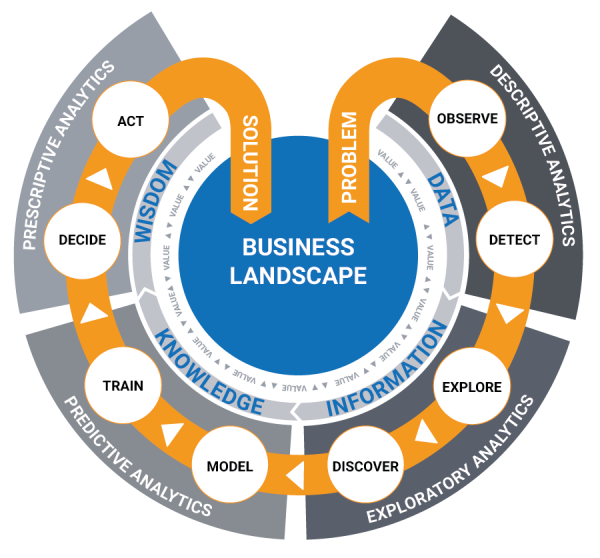Perioperative Analytics: Exploratory Data Analysis in the OR (Part 1 of 4)

The vast swathes of data being collected in modern health systems suggest that perioperative analytics (or OR analytics) are at the ready. The truth is that extracting meaningful information from all those data points takes some coordination and a little exploration. Let’s take a look at the exploratory data analysis that underscores analytics, and the different ‘flavors’ of perioperative analytics, from descriptive and diagnostic to predictive and prescriptive.
Imagine yourself in a situation where you are faced with the distress of having to undergo surgery to address an ailment. As a patient, what would be your top-of-mind concerns? You would think about how risky the operation is. How long the recovery will take. Which physician is going to perform the procedure. What the physician’s reputation is. And ultimately, what are your chances of healing from the underlying medical issue you’re getting the surgery for in the first place. That all makes sense. You are one patient facing one concern: your health and wellbeing.
If we look at it from the healthcare organization’s perspective, it is comforting to know that a successful patient outcome is the primary goal for each and every surgery. However, how the overall hospital or health system supports that patient outcome is decidedly different and complex. From clinical workflows and the facilities involved to the role of administration and supply chain, the organization is balancing a broad set of factors and concerns to ensure they provide you with the best healthcare possible. One such concern is having the perioperative analytics to ensure the right products and instruments are available in the right quantity and at the right time.
“Exploration is what you do when you don’t know what you’re doing. That’s what scientists do every day. If a scientist already knew what they were doing, they wouldn’t be discovering anything…”
– Neil deGrasse Tyson
In my burgeoning role as a data scientist, I am embarking on a journey of exploratory data analysis (EDA); I will be looking into historical indicators within a perioperative product usage context. The aim of this data-driven journey is to discover whether there are any business process insights that may be leveraged from the hospital supply chain at the point of use.
Although EDA will likely raise more questions than answers—especially at the beginning—it also has the potential to address questions that have not yet been asked. More often than not, data scientists come from outside the line of business they are analyzing. They typically lack the detailed expertise (in this case, clinical expertise) for which they are trying to extract data-driven business insight. Depending on one’s perspective, this lack of expertise can be either a blessing, a curse—or both. I have experienced this first-hand.
The Blessing and the Curse
Looking purely at the data is initially overwhelming. When you first lay out a 2,000-piece jigsaw puzzle of a blue sky, it’s hard to know how to start putting those pieces together. Datasets are really just millions of puzzle pieces waiting to be assembled in a way that makes analytical sense. Unfortunately, there’s no picture of the finished product to use for reference!
Data science begins with aspirations of extracting precious business insight from this goldmine of information. This is coupled with tabula rasa freedom to look at things in ways that have not been conceived before. The blessing, if you will.
However, delving into the data and getting a feel for its overwhelming size and complexity, coupled with gaps in clinical knowledge, can mean the experience might quickly devolve into conjuring up images of uncertainty and doubt. In my case, the latter takes the form of a silent, discouraging, internal monologue: Where do I start? What do I look for first? How will I find business insight for a subject with which I am not terribly familiar? The ‘curse’ seems to have settled in.
Probability Lies in the Patterns of the Past
It is said that the journey of a thousand miles starts with a single step. For jigsaw puzzle veterans, that first step is probably to look for the edge pieces (patterns in the shape) followed by clusters of color patterns.
For data scientists, that first huge step is to look into the past (through the data, of course) and see what has happened. If I have a basic overall understanding of the business process behind the data, it is likely I can make general sense of what is going on. Luckily for me, I have access to superb domain expertise via the Tecsys application teams and business analysts. They are excellent resources that can provide business process guidance when the going gets tough, and believe me it will. So, by dovetailing Tecsys’ extensive healthcare supply chain knowledge with my focus on data science, we’ll be able to find those connections and begin forming a picture of what’s going on.
At any time, there is the distinct possibility that the data will seem to challenge my general understanding of the original premise. Why has it happened? Why has the business behaved the way it has? As a data scientist, did I understand the business process properly, or are there gaps in my knowledge that need further expertise to explain? Am I reading and interpreting the data properly or is there a deviation from the established business process norm?
Using the Past to Chart a Course Ahead
It is generally known that history tends to repeat itself. So, if I build a sufficient understanding of what has happened and why, could this predict something about the future? Can the data tell me whether it will happen again? The science of statistics and probability theory are in my favor; if I have enough data informing what occurred and why, I may be able to predict with reasonable odds whether it will happen again, and when.
As we funnel deeper into the abstract, if I am able to ascertain what is likely to happen, could I potentially leverage that information to do something about it? Could I promote (or deter) a particular likelihood of an outcome? Wouldn’t that be interesting?
What could I learn from this entire endeavor? Could I potentially get a handle on the drivers of this data and the myriad processes it represents? Dare I say there is opportunity to learn from it and port that knowledge into other entities that can then act on it?
A Springboard for Analytics
The introspective questions I ask form the basis of many well-established data explorations systematically designed to carefully lead from one (albeit oversized) analytical step to the next.
- Analyze the data to see what has happened (descriptive perioperative analytics).
- Decipher and explore the why behind it (exploratory perioperative analytics).
- Anticipate certain process eventualities (predictive perioperative analytics).
- Recommend a set of actions (prescriptive perioperative analytics).
- Learn from the overall process and potentially automate the decision processes governing it (cognitive perioperative analytics).

Certainly, it is also important to keep in mind that each of the analytical steps above has its roots in technology (what tooling to use), methodology (what approach to take), and finally outcome (what solution to recommend).
VP Distinguished Analyst Noha Tohamy from Gartner has written three excellent research notes that I have leveraged as additional guides through this journey. They touch upon the analytical techniques (G00347140); talent, organization, and technology (G00349011); and business use case prioritization and ROI (G00349014) necessary for such an endeavor to be successful.
Join Me on the Journey
This is the first in a four-part series in which I will apply data science to the OR and investigate applications for descriptive, exploratory, predictive, prescriptive, and cognitive analytics within the perioperative healthcare supply chain.
Keeping an open mind, with a sense of adventure towards data exploration, armed with analytical methodologies on one side and technologies on the other, coupled with real-world data and access to superb, world-class Tecsys Supply Chain Management business acumen and guidance—I forge ahead.
I invite you to accompany me on this virtual journey of Exploratory Data Analysis and Discovery in the OR. Through this series, I will document my findings and share any insights I come across. Who knows when and how the journey will end, and what it will unravel. In that respect, may fortune favor the bold!
You can access the rest of the posts in this series here: part 2, part 3, part 4.


